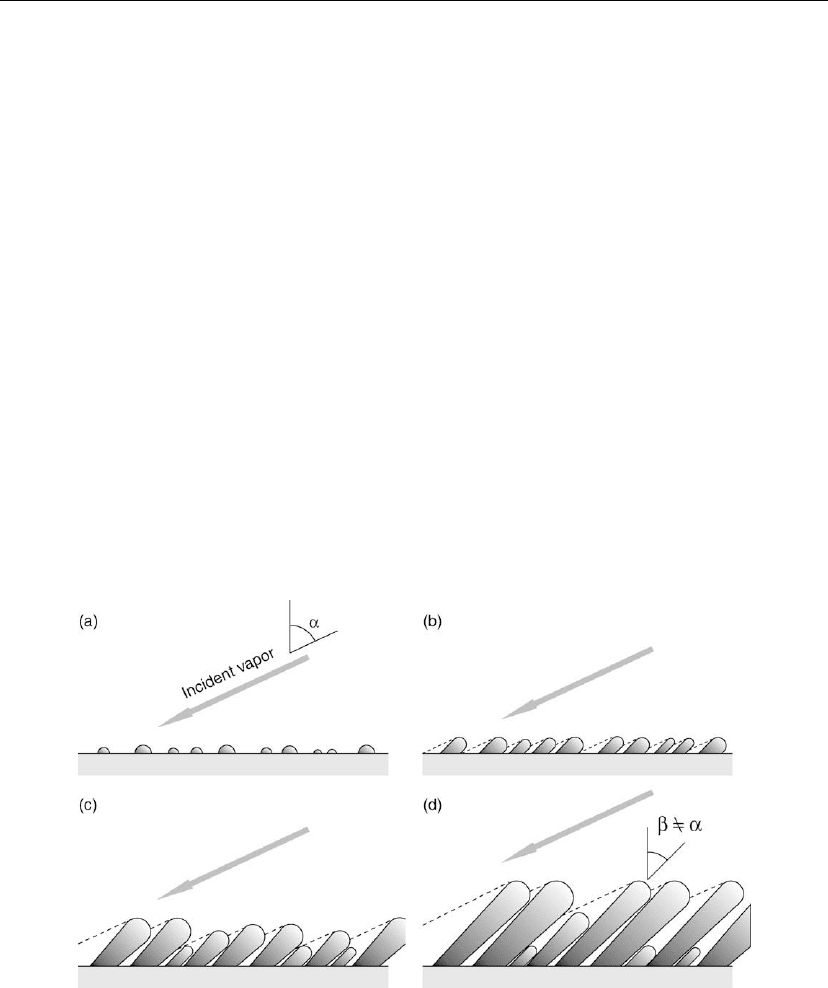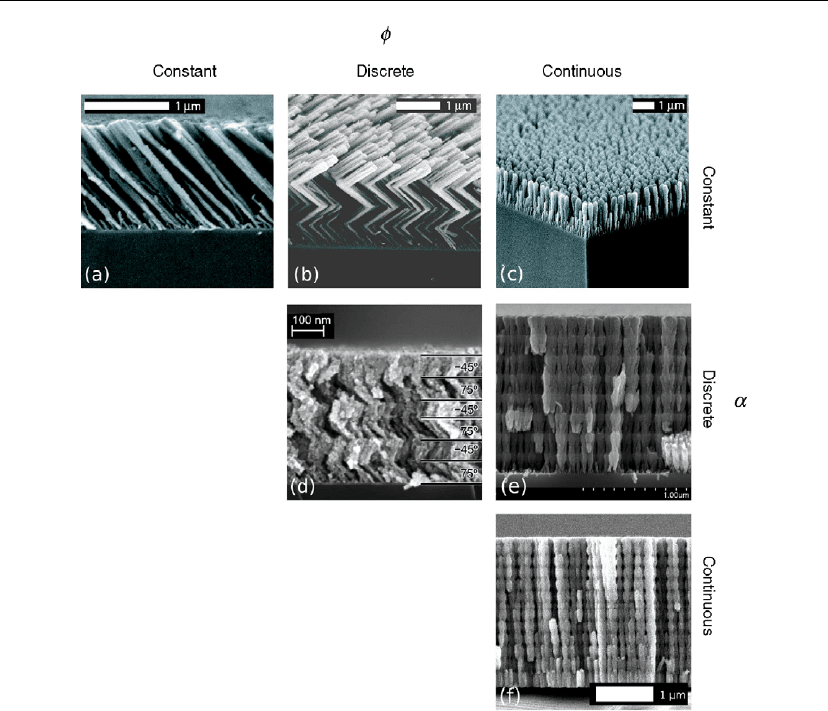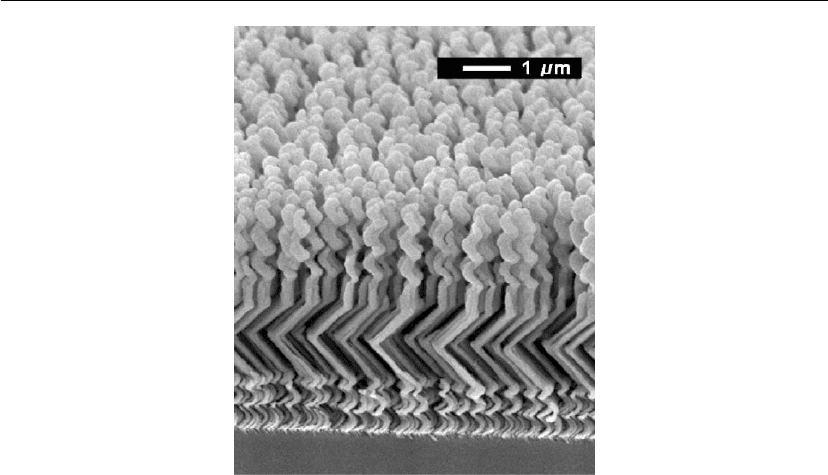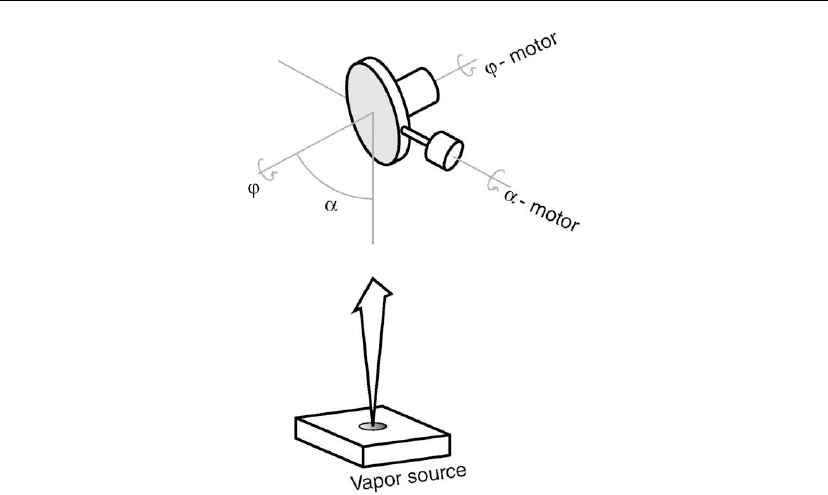Martin P.M. Handbook of Deposition Technologies for Films and Coatings, Third Edition: Science, Applications and Technology
Подождите немного. Документ загружается.


CHAPTER 13
Glancing Angle Deposition
Michael T. Taschuk, Matthew M. Hawkeye and Michael J. Brett
13.1 Introduction 621
13.2 Theory, Structures and Apparatus 623
13.2.1 GLAD Theory 623
13.2.2 Basic GLAD Structures 626
13.2.3 GLAD Apparatus 629
13.2.4 Demonstrated Materials 633
13.3 Advanced GLAD Processes 633
13.3.1 Predeposition Treatment: Substrate Seeding 633
13.3.2 Advanced Deposition Methods 638
13.3.3 Postdeposition Treatments 644
13.4 Properties of GLAD Thin Films 646
13.4.1 Column Properties 646
13.4.2 Column Ensemble Properties 652
13.4.3 Bulk Properties 656
13.4.4 GLAD Properties Summary 660
13.5 GLAD Applications 660
13.5.1 Optical 661
13.5.2 Sensors 665
13.5.3 Mechanical Devices 667
13.5.4 Applications in Catalysis 667
13.5.5 Magnetic Tape Data Storage 668
13.5.6 Energy Applications 668
13.5.7 Microfluidics 670
13.5.8 Manufacturability of GLAD Thin Films 670
13.6 Summary 671
13.1 Introduction
Oblique angle deposition has been of interest to the thin film community for more than 100
years owing to enhancement of properties such as dichroism, birefringence, and anisotropic
resistivity [1–4]. The film microstructure which produces these novel properties and
Copyright © 2010 Peter M. Martin. Published by Elsevier Inc.
All rights reserved.
621

622 Chapter 13
Figure 13.1: SEM images showing increasing control offered by the GLAD technique over the past
15 years: (a) early spirals, (b) early chevrons, (c) top–down view of Alq
3
spirals, and (d) Si square
spiral. (a) and (b) are from 1994, (c) and (d) are from 2007. All scale bars are 1 m.
capabilities depends on ballistic shadowing and formation of columnar microstructures during
deposition.
Glancing angle deposition (GLAD) is an extension to oblique angle deposition where the
substrate position is manipulated during film deposition. Although some early experiments
used mobile substrates [5], oblique depositions are typically performed with a fixed substrate.
GLAD developed as researchers realized they could manipulate the columnar structure by
actively managing substrate position during deposition. Structures produced by GLAD have
steadily improved in sophistication and quality as seen in Figure 13.1; modern GLAD
implementations require real-time feedback and computer control of substrate position.
Applications already demonstrated and those under investigation include:
active and passive optical devices using numerous materials, providing design
flexibility and creating characteristics useful in retarding elements, circular polarizers
and polarized light emitters, among others;
sensor devices (pressure sensors, optical resonators, humidity sensors, nanomotors);
energy devices (electrochemical supercapacitors, microbattery charge storage, fuel
cells, solar energy conversion).
Although GLAD has seen some impressive developments over the past 15 years, there is an
extremely large parameter space available and the true complexity is not yet well understood.
Empirical studies are far ahead of theoretical ones, because the key advantage of GLAD
films – simultaneous control of multiple size scales – makes theoretical studies of GLAD films
a challenge. Today, the dominant applications reflect large-scale effects; for example, optical
properties are well understood. Even mid-range effects, such as surface area and mechanical
properties, can be addressed experimentally and rest on reasonably developed theoretical
models. Nanoscale applications, on the other hand, have been constrained by current limits on

Glancing Angle Deposition 623
simulation size; as a better understanding of GLAD’s nanoscale physics develops, exciting
new applications of GLAD films are anticipated.
Readers interested in the technique’s historical development are referred to the patents [6–8],
reviews [9–12], and a book [13] which cover GLAD. This chapter focuses on experimental
aspects of the GLAD technique – its methods and possibilities. Section 13.2 introduces the
basic theory, and describes the canonical microstructures and apparatus required to produce
GLAD films; Section 13.3 describes advanced GLAD techniques, covering procedures which
occur before, during, and after a GLAD process; Section 13.4 discusses the properties of
GLAD films at several length scales: single column properties, the properties of an ensemble
of columns, and the ‘bulk’ properties of a GLAD film; and Section 13.5 reviews applications
and devices made with GLAD films.
13.2 Theory, Structures and Apparatus
This section defines important terms that are used in the GLAD field to describe substrate
position, geometric aspects of GLAD apparatus, film properties, and characteristic column
morphologies. The first use and definition of such terms are indicated in italic. We note that
some of the symbols used to represent the terms defined here are not used universally in the
GLAD field, so some care must be exercised when examining the literature.
13.2.1 GLAD Theory
13.2.1.1 Incident Vapor Collimation
Ballistic shadowing is the foundation of GLAD-based thin film engineering. Such shadowing
is only possible if the incoming vapor flux is well collimated. If there is a large angular spread
in incoming vapor flux, shadows will be poorly defined. Two main approaches achieve
collimated vapor flux: large distance between vapor source and substrate, and physical
obstacles which select a subset of an uncollimated vapor plume. For a fixed substrate size, as
distance from the source increases, incident vapor collimation improves. However, the number
of collisions also increases the farther the vapor flux travels before reaching the substrate. To
fabricate high-quality structures, the vapor mean free path should be larger than the
source–substrate distance. This is easily achieved with electron-beam evaporation systems,
widely used for GLAD depositions.
However, some materials are not suited to electron-beam or other evaporation methods.
Techniques such as sputtering may be used, but at the cost of a wider angular distribution due
to large target size and scattering from the working gas. In such cases, a physical screen which
selects a subset of incident flux can restore collimation [14]. If even higher pressures must be
used, alternative deposition techniques can maintain GLAD conditions. Sun et al.
demonstrated reactive-pulsed-laser deposition of GLAD ZnO films at 0.1 torr, approximately

624 Chapter 13
three orders of magnitude above typical electron beam pressures [15, 16]. GLAD was still
possible at such high pressures owing to an extremely oblique vapor flux, and a laser focal spot
of ∼3mm
2
which produces a very small angular distribution.
13.2.1.2 Film Nucleation and Column Growth
The previous chapter detailed film nucleation, growth, and microstructure evolution. Here we
discuss only aspects of film nucleation that are important for producing GLAD thin films.
During oblique deposition at an angle α, defined in Figure 13.2(a), any surface topology is
amplified by ballistic shadowing. A nominally planar substrate will roughen through
Volmer–Weber mode growth; any defects in the substrate will accelerate roughening [17]. This
initial stage of GLAD film growth is given schematically in Figure 13.2(a).
The arrival of vapor flux and formation of film nuclei is a random process. The nuclei grow
into columns, seen in Figure 13.2(b), and develop shadows. The columns and shadows they
cast will have a size distribution. As a result, some nuclei will screen neighboring nuclei from
incoming vapor flux, suppressing their growth (Figure 13.2c). Given sufficient time, smaller
nuclei and columns can become completely shadowed and stop growing. This process,
referred to as column extinction and seen schematically in Figure 13.2(d), continues
throughout the growth of a GLAD film.
Figure 13.2: Schematic view of GLAD growth: (a) initial arrival of vapor flux at an angle α,
producing a random distribution of nuclei on substrate surface; (b) nuclei grow, casting shadows
across substrate; (c) columns develop, partially shadowing smaller neighbors and suppressing
their growth; (d) columns grow at an inclined angle. Some columns have become extinct, fully
shadowed by larger neighbors. Further growth is restricted to the top of columns.

Glancing Angle Deposition 625
As the nuclei grow, more incoming vapor flux will deposit on them. This self-reinforcing
behavior develops isolated columns, provided that adatom surface mobility is low. Thus,
GLAD principally occurs in zone I of Movchan and Demchishin’s structure zone model [18],
where T
substrate
∼≤0.3T
melting
limits surface diffusion, leading to the formation of columnar
grains. Eventually, only the top of nuclei are able to grow, developing into columns tilted
towards the vapor source. Column tilt angle is described by a single angle, β, shown in Figure
13.2(d). When a column is parallel with the substrate normal, β =0
◦
, and would be = 90
◦
for a
column parallel with the substrate surface. For some of the GLAD structures described in
Section 13.2.2, it is possible to exhibit multiple values for β. Section 13.2.1.3 gives a detailed
discussion of the variables affecting column tilt angle.
13.2.1.3 Column Tilt Angle
It has long been known that column tilt angle in oblique depositions does not fully follow the
incidence angle of vapor flux. Various rules have been proposed to describe this behavior, but
the experimental data reveal a dependence that cannot be described by a single relationship.
The growth of GLAD columns depends on shadowing between columns, deposition
temperature, deposition rate, deposition pressure, vacuum composition, substrate type,
substrate preparation, and preferred crystallinity of the deposited material. Under these
conditions, the general relationships known as the tangent rule and Tait’s rule must be
understood as guidelines only. For applications in which precise column tilt angle is important,
these rules should be verified for any material system that has not been studied in the literature.
The tangent rule was one of the early attempts to describe the experimental data by
Nieuwenhuizen and Haanstra [19], who proposed the relationship
tan α = 2 tan β (13.1)
Hodgkinson et al. generalized the tangent rule, adding a fitting parameter that could be used to
describe differences in material tilt angles [20]. However, as the deposition angle becomes
increasingly oblique, the tangent rule fails to describe experimental data. Using a ballistic
model for columnar growth, Tait et al. derived the following relationship [21]:
β = α − arcsin
1 − cosα
2
(13.2)
Although these rules can successfully provide a first order approximation of the expected
behavior of β, the actual behavior of GLAD films can be perturbed from these relationships by
several factors. Increased temperature has been shown to reduce β [22, 23], although
non-monotonic behavior has also been observed [24]. Increased deposition rate has been
shown to increase β for Fe thin films [25, 26], as has decreasing chamber pressure [25, 27].
Data from Lintymer et al. suggest that the effect of chamber pressure is more pronounced at

626 Chapter 13
higher α [27]. Differences between materials are observed [20], and different crystalline
phases of a single material can have a significant effect [26]. The interaction between substrate
and deposited film can also have an impact, and must be determined on a case-by-case basis
[24]. Finally, some advanced GLAD substrate motion control techniques can decrease β in a
controlled manner (see Section 13.3.2.1) and limited increases can be achieved through
techniques such as ion-assisted GLAD (see Section 13.3.2.4).
13.2.1.4 Film Density
As part of Tait’s geometric model for column growth, an expression for GLAD film density
was derived [21]. Density is expressed in terms of ρ
0
, the density of a film deposited at α =0
◦
,
and may be written as
ρ = ρ
0
2cosα
1 + cosα
(13.3)
Once again, this relationship can successfully provide a first order approximation of ρ, but the
same caveats expressed in Section 13.2.1.3 about the tangent and Tait’s rule also apply here.
Exceptions to this relationship are known to exist, and for applications sensitive to small
variations in density this equation must be verified.
13.2.2 Basic GLAD Structures
Substrate orientation is described in terms of two angles, defined in Figure 13.3. The
deposition angle, α, defines the incidence angle of vapor flux: an α of 0
◦
occurs when the
substrate normal is pointed directly at the source; an α of 90
◦
occurs when the substrate normal
is perpendicular to a line between the center of the substrate and the center of the vapor source.
The substrate rotation angle, φ, defines the azimuthal substrate position relative to an arbitrary
starting position. While φ is periodic, in practice tracking the absolute angular displacement of
Figure 13.3: Schematic of the substrate coordinate system, showing the angle α, φ, and γ. The
incident vapor vector and substrate normal define the deposition plane.

Glancing Angle Deposition 627
a substrate is useful. In this chapter, substrate positions will be described using an ordered pair
notation: (α, φ). For some advanced techniques, it is useful to define an offset angle, γ,
describing a temporary deviation from φ. This angle will be recorded separately: (α, φ + γ).
Analogous to optics, we define deposition plane, defined by the substrate normal and a line
connecting the center of the substrate with the center of the vapor source. Shadowing occurs
only in the direction parallel to the incident vapor flux. As a result, there is no mechanism for
limiting column growth in the transverse direction, leading to column broadening. The
columns can continue broadening until they merge with adjacent columns [28]. Some methods
discussed in Section 13.3 are designed to minimize the effects of column extinction and
broadening.
The basic GLAD structures are shown in Figure 13.4, categorized by the variation of α and φ
during deposition. The behavior of both α and φ is broken into three categories: constant,
discrete and continuous. A constant designation means that the substrate remains stationary at
a given angle during a deposition. A discrete designation means that the substrate undergoes
periodic changes in a given angle, but remains stationary otherwise. A continuous designation
means the substrate is in motion continuously during a deposition for the specified angle.
While most examples of discrete and continuously varying substrate positions are periodic,
there is no requirement that periodicity be retained. There are nine possible combinations of α
and β motions, but only six are in common use. The six basic GLAD structures offer a wide
selection of film morphologies, each of which is described below. Substrate angular velocities
are described in terms of deposited film thickness (measured along substrate normal), and are
denoted α
or φ
.
Slanted posts occur when a substrate is held stationary ((α, φ), α
= φ
= 0) during a deposition.
For isolated posts, α is typically above ≈70
◦
. Chevrons are produced by depositing a series of
slanted posts. The substrate is held at (α, φ) for one arm of the chevron, followed by deposition
of an additional arm with the substrate held at (α, φ + π). This sequence has been repeated
twice for the film shown in Figure 13.4(b). Square spirals fall into the same category as
chevrons, but with a π/2 rotation at discrete intervals.
Vertical posts are produced by rotating the substrate at a constant rate during deposition
((α, φ(t)), α
=0,φ
= k). As seen in Figure 13.4(c), vertical posts can experience broadening
during growth. The rate of rotation is an important parameter in controlling vertical post
morphology [30]. Helical thin films can be produced using slower rotation rates.
A slanted post stack is produced with discrete changes in both α and φ during deposition, such
that the substrate adopts the orientations: (α
1
, φ
1
), (α
2
, φ
2
), etc. For the case pictured in Figure
13.4(d), φ = nπ, where n is layer number.
High–low stacks are produced with a continuous rotation in φ, and discrete changes in α. Such
films are well suited for optical applications: the film in Figure 13.4(e) is a Bragg stack. To

628 Chapter 13
Figure 13.4: The basic GLAD structures: (a) slanted post; (b) chevron; (c) vertical post;
(d) slanted post stack; (e) high–low stack and (f) rugate. These structures are fabricated using
constant, discrete and continuous motion in α and β. ((a–c) Reproduced with permission from
[29], (d) reprinted with permission from [108], © 2007 American Institute of Physics.)
produce a Bragg stack, the optical thickness of each layer should be λ/4. Substrate motion is
defined by a repeating sequence: (α
1
, φ(t)), φ
= k;(α
2
, φ(t)), φ
= k.
Rugate filters are produced with a continuous rotation in both α and φ. Substrate motion can
be described approximately as (α(t), φ(t)), α ≈asin(t)+α
0
, φ
= k. The exact functional form
of α must be chosen to produce a sinuisodal index profile. The required α profile depends on
the optical properties of GLAD films, discussed in Section 13.4.3.1. Capping layers and
graded density films are also members of this category.

Glancing Angle Deposition 629
Figure 13.5: Combination of several structures from Figure 13.4. From bottom to top, this
structure is composed of a helix, a one-period chevron, a short vertical post, and finished with
another helix. (Reproduced with permission from [31].)
The six basic structures shown in Figure 13.4 can be combined to make very sophisticated
structures, as seen in Figure 13.5. From bottom to top, this film was produced by combining a
helix, chevron, vertical post, and another helix. Additional modifications to the basic structures
described here are the subject of Section 13.3.
13.2.3 GLAD Apparatus
A schematic of a GLAD-capable physical vapor deposition (PVD) system is shown in Figure
13.6(a). The deposition angle α is defined as the angle subtended between the substrate normal
and the incident vapor. Azimuthal rotation about the substrate normal is measured by the angle
φ. In general, a line connecting the centers of the substrate and vapor source goes through the
maximum of vapor flux plume.
Substrate rotation alters the location of the vapor source from the perspective of the growing
columns. This changes the shadowing dynamics and the column growth will follow the source
location. The manipulation of substrate orientation can therefore sculpt column growth,
leading to the term sculptured thin film (STF), often used in the literature.
The requirements of a GLAD system vary with the required structures, since the necessary
motions vary. A thorough description of a very capable system is given by Robbie et al. [11].

630 Chapter 13
Figure 13.6: Schematic of GLAD apparatus and characteristic angles.
This section gives an overview of the requirements for a fully functional GLAD system
capable of manufacturing the structures shown in Figure 13.4, and combinations thereof. In
addition, system operating procedures specific to GLAD are discussed. It is worth noting that
limited retrofits to existing deposition systems can make them GLAD capable.
13.2.3.1 Pressure Requirements
As discussed in Section 13.2.1.1, ballistic shadowing of incoming vapor flux is critical for
GLAD. As a result, a flexible GLAD system should have a mean free path longer than the
chamber dimensions. For typical systems with a source–substrate distance of ≈ 45 cm, an
operating pressure of ≈≤10
−3
torr is required. While these constraints vary with source type
used, in general a lower operating pressure is preferred for production of high-quality
structures.
13.2.3.2 Vapor Sources
Many vapor sources have been used for GLAD, including electron-beam evaporation,
thermal evaporation, sputtering, several co-sputtering techniques, and pulsed-laser deposition.
Table 13.1 summarizes materials and vapor sources used in GLAD.
13.2.3.3 Substrate Motion
To produce the structures shown in Figure 13.4, it is necessary for the substrate to be able to
assume any orientation between (0, 0) and (π/2, ≈∞). This may be accomplished using two
